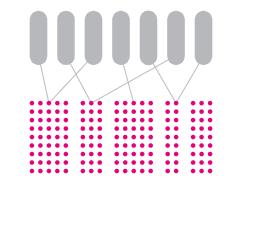Polkadot was launched as an open-source project in 2017 by Parity. The project was supported by the Web3 Foundation, a Swiss foundation that aims to focus on building a fully functional and user-friendly decentralized web. It is founded by Dr. Gavin Wood, Robert Habermeier, and Peter Czaban. Wood is also the co-founder of Ethereum.
Polkadot aims to provide a framework for building your blockchain and offers seamless, transparent, and smooth communication of any data or information among different blockchains.
The platform offers many distinct features that help in achieving the solution offered by the network. It includes heterogeneous sharding, scalability, upgradeability, transparent governance, and cross-chain composability, which is not present in the existing networks.
Table of Contents
Polkadot Versus Ethereum
Ethereum and Polkadot are both very strong and innovative projects. They both offer a facility to build decentralized applications and smart contracts, not to mention being scaled by using parallel execution.
Despite these similarities, there are certain differences between these two platforms.
One of the major differences is the design goals. Ethereum aims to provide a platform for distributed finance and smart contract execution, whereas Polkadot aims to provide a framework for building your blockchain and an ability to connect different blockchains.
Distinct Features of the Polkadot Network
Below are the important features of the Polkadot network.
Heterogeneous Sharding
Based on the heterogeneous sharding model, Polkadot can connect multiple chains in a single network. These chains can process the transactions in parallel and can securely exchange data between chains. Each chain can be optimized to cater to a specific use case. Thus, more specialization gives rise to more possibilities for innovation.
Scalability
The sharding model allows parallel processing of multiple transactions. This model will help in removing the issue that exists on earlier networks due to sequential transaction processing. The network is planning to implement a new feature known as nested relay chains, which will increase the number of shards that can be added to the network in the future.
Upgradeability
Every application needs an upgrade to incorporate the latest features and changes. However, if we talk about blockchain, the upgradation process is not that simple.
Blockchain upgrades sometimes require forking the network, which involves a lot of time and effort. Also, in the case of hard forks, a unanimous community decision is another issue.
The Polkadot network supports the blockchains to upgrade themselves without the need to chain fork. Of course, these forkless upgrades are regulated through Polkadot’s transparent on-chain governance system. This feature allows the projects based on Polkadot to stay agile, adapting and evolving with the pace of technology.
Transparent Governance
DOT holders maintain the Polkadot network. They can vote on an existing proposal or can create a proposal to upgrade/implement changes to the protocol.
Cross-Chain Composability
Polkadot supports cross-chain communication. The shards can pass messages to communicate, exchange value, and share functionality. Using this feature, Polkadot shards will be able to interact with external networks.
Polkadot Architecture
The Polkadot network consists of a large number of heterogeneous blockchain shards called parachains. These parachains are connected and secured by the Polkadot Relay Chain. They can connect with external networks via bridges.
Relay Chain
The Relay Chain is the central chain of Polkadot, and it is responsible for the network’s security, consensus, and cross-chain interoperability.
- Composed of a small number of transaction types
- Less functionality, does not support smart contracts
- Coordinate with the system as a whole, including parachains
- Validators stake DOT on the Relay Chain and validate for the Relay Chain
Parachains
A parachain is an application-specific data structure that is globally coherent and validatable by the validators of the Polkadot Relay Chain.
- Parachains support parallel transactions and help in achieving scalability of the Polkadot system.
- Parachains can be optimized for specific use cases.
- They need to pay or lease a slot to connect to the Relay Chain.
- Parachains are connected to the relay chain. The relay chain validates the state transition of connected parachains, thus helping in maintaining a shared state across the entire ecosystem.
Parathreads
Parathreads offer the same benefits that a full parachain has. It can pass messages to another para (chain, threads) through XCMP, and it is secured under the full economic security of Polkadot’s validator set.
The difference between parachains and parathreads is the fee structure. The registration of parachains occurs using a governance proposal or parachain slot auction. Parathreads have a fixed fee for registration that is much lower than the cost of acquiring a parachain slot.
Bridges
Bridges are the special blockchains that allow Polkadot shards to connect to and communicate with external networks like Ethereum and Bitcoin.
Consensus Roles
Below are the various consensus roles in the Polkadot Network.
Validators
Validators secure the Relay Chain by staking DOT, validating proofs from collators, and participating in consensus with other validators. These participants are responsible for adding new blocks to the Relay Chain and, by extension, to all parachains.
Validators perform two functions:
- Verifies the information contained in an assigned set of parachain blocks (such as the identities of the transacting parties and the subject matter of the contract).
- Participate in the consensus mechanism to produce the Relay Chain blocks based on validity statements from other validators.
Collators
Collators maintain shards by collecting shard transactions from users and producing proofs for validators. The collator node maintains a full-node of the parachain and retains all necessary information of the parachain, and it produces new block candidates to pass to the Relay Chain validators for verification and inclusion in the shared state of Polkadot.
Nominators
Nominators secure a Relay Chain by selecting trustworthy validators and staking DOTs.
Fishermen
Fishermen monitor the network and report bad behavior to validators. Collators and any parachain full node can perform the fisherman role.
The DOT Token (DOT)
DOT is the native token of the Polkadot network.
DOT has mainly three distinct purposes:
- Used for the governance of the network
- Staking
- Bonding
Join us on Telegram to receive free trading signals.
For more cryptocurrency news, check out the Altcoin Buzz YouTube channel.





































